Steelhead Fishing With Beads: 5 Guide Tips For More
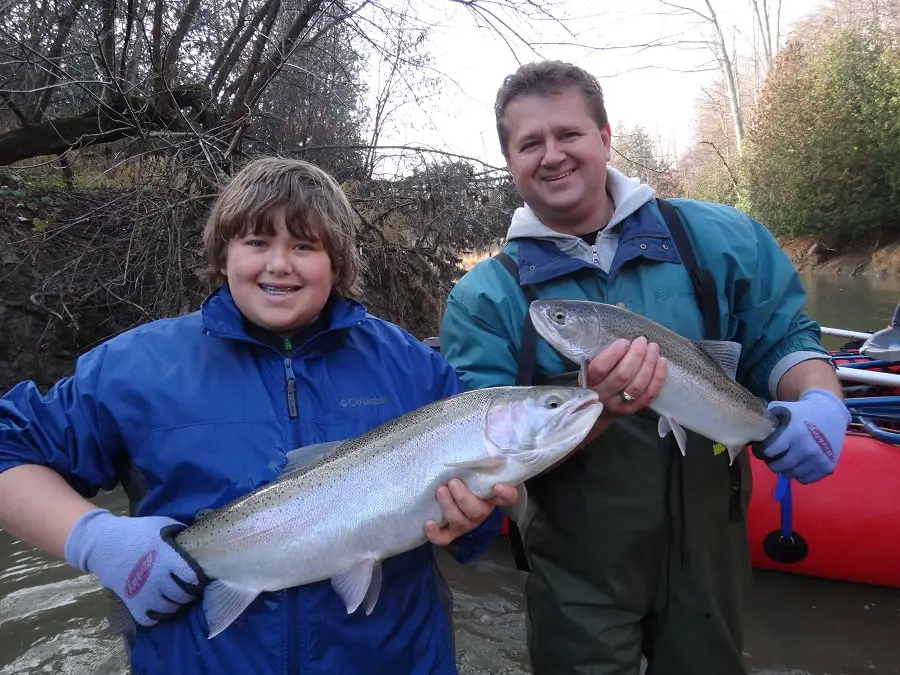
I have been steelhead fishing with beads in rivers for over fifteen years. Beads are one of my three go-to baits I use when I’m guiding because they imitate single-free drifting salmon or trout eggs that steelhead love to eat.
Fishing with beads is an excellent technique for steelhead but only if you use the right bead types, sizes, colors, and hooks. You also need to be sure that you use the right setup and fish the beads well is you want to significantly catch more steelhead.
In this article, I will share valuable insights on bead selection, rigging methods, tips for changing beads quickly, and some tips that will improve your steelhead bead fishing game.
Bead Selection: Trout Beads, Steelhead Beads, or Just Beads?
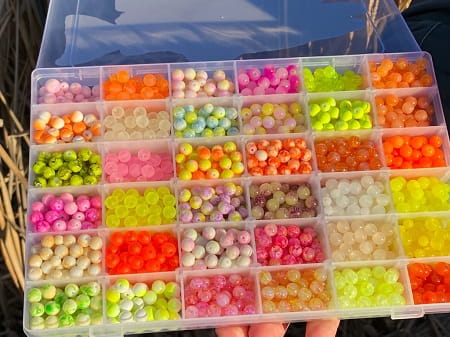
Beads, whether referred to as trout or steelhead beads, essentially serve the same purpose: to imitate salmon or trout eggs and catch steelhead.
Steelhead beads are made from different materials, such as glass, plastic, and even rubber, and they come in a variety of sizes and colors.
All types have their advantages, and I will discuss the pros and cons below.
Steelhead Fishing With Beads In Rivers
I only use beads in rivers with the current. Since beads are artificial with no scent and a hard texture, in a river, as the beads drift past the steelhead they have less time to inspect the bait, so they either grab it or they don’t. Beads are not good in still water.
Methods of Fishing for Steelhead With Beads
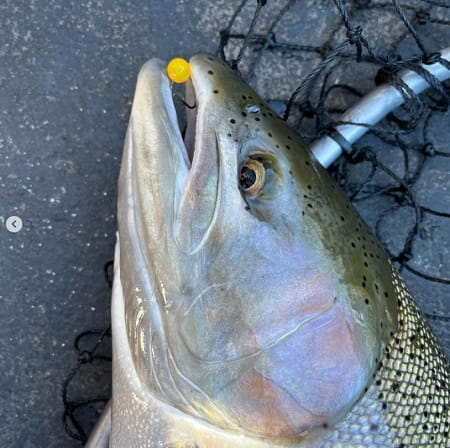
Fishing with beads for steelhead can be done using various techniques, including float fishing, drift fishing, and bottom bouncing. I’ll even use beads when fly fishing.
Steelhead Bead Sizes
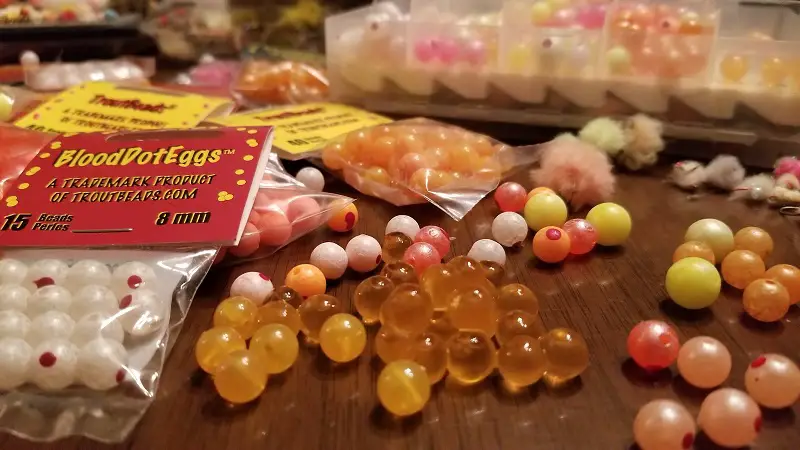
Beads are available in four sizes suitable for various water conditions. A 6mm bead is similar in size to the eggs of brown trout or rainbow trout, while an 8mm bead replicates the size of a typical salmon egg.
The 8mm bead size is the most common size and is effective in any river, regardless of the presence of salmon.
Larger beads are more visible in faster currents, making them more enticing to steelhead.
Under clear water conditions, I use smaller 6mm beads. For dirtier or slightly off-colored water, a 10mm or even 12mm steelhead bead may be used. I have found that 8mm beads are good in clear to slightly murky water.
Best Bead Colors for Steelhead
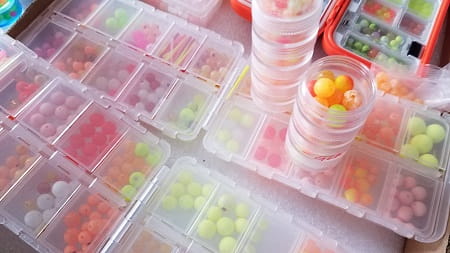
The ideal bead colors for steelhead fishing are often shades of yellow, orange, and pink.
However, the choice of colors depends on water clarity and light conditions.
Different brands offer a variety of color options, including mottled beads and blood dot beads, which are just colored beads with a red dot on them.
The effectiveness of specific colors may vary, so it’s important to experiment and observe which colors yield the best results in different fishing situations.
I have spent years experimenting with all the colors and sizes in all types of conditions and through the seasons. Follow my bead charts for which colors are best based on the conditions.
See my color charts below with the three types of beads.
Advantages of Plastic Beads for Steelhead Fishing
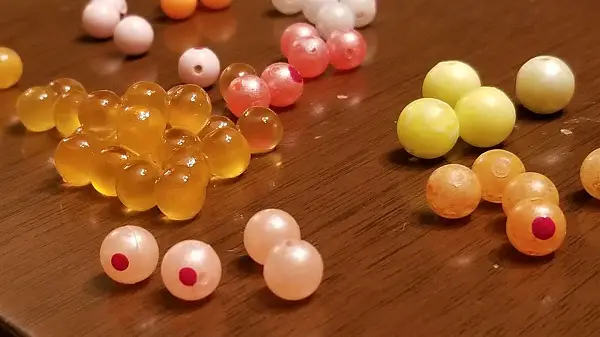
I use hard plastic beads, such as the popular TroutBeads brand, which are widely used for steelhead fishing due to their availability and affordability compared to glass beads.
Hard plastic beads are slower sinking than heavy glass beads and are more suitable for shallower rivers under four feet deep, as they don’t need to sink as deep as glass beads.
However, I tend to use the plastic beads more than all other beads because, as long as your leader is set up and weighted properly, I find that the buoyancy of the lighter beads provides a more realistic appearance, similar to a real salmon eggs drifting with the current, which can entice more bites.
There are many anglers claiming glass beads are more effective, which I will discuss below.
Plastic beads come in a wide range of colors and sizes, offering versatility in different fishing situations. Plastic beads are especially effective in rivers with sandy bottoms or when targeting steelhead in shallower water.
Clear Water Use: 6mm and 8mm | Medium Clear Water Use: Size 8mm is best | Dirty Water Use: Size 10mm or 12mm |
Peach Roe | Egg Yolk | Chartreuse |
Salmon | Natural Roe | Hot Cherry Roe |
Glow Roe | Orange-Clear | |
Peach Fuzz | Gold Roe | |
Apricot Swirl | Mottled Natural Roe | |
Gold Roe | Pink | |
Milt Roe | Cerise |
Benefits of Glass Beads for Steelhead Fishing
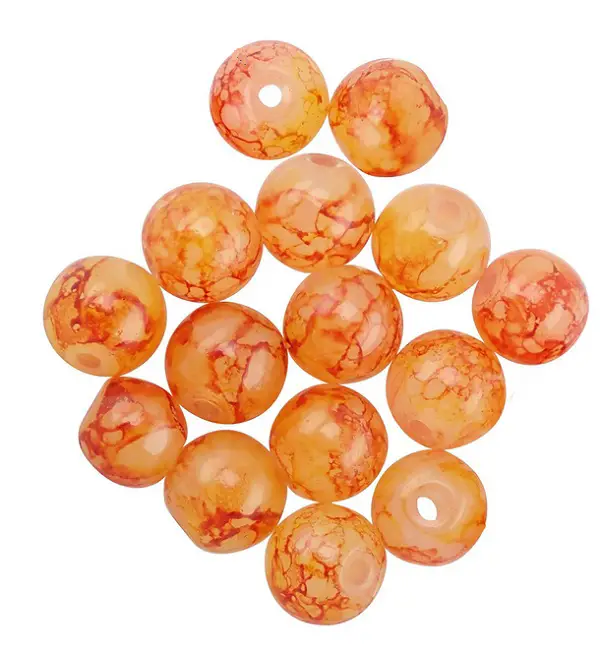
Some anglers believe that glass beads outperform plastic beads when it comes to attracting steelhead, and I would bet for most anglers that is true.
The main advantage of glass beads lies in their weight, which allows them to sink quickly and remain in the strike zone for a longer duration. For this reason, many anglers will benefit.
However, it is important to note that the effectiveness of glass beads may be attributed to factors such as the angler’s presentation and their leader setup.
After watching thousands of anglers fish, I still believe most anglers do not get their boats deep enough, which is usually due to improper leader setup and the ability to detect the bottom and adjust their presentation.
Glass beads are heavy, like a weight, and they get deep, which is why I believe they catch more steelhead than identical-looking plastic beads.
If you find that glass beads yield better results, consider adjusting your presentation technique or just add more weights and length to your leader to achieve greater depth with the lighter baits.
For glass beads, I and many anglers prefer the beads from, Creek Candy Bead Company.
Clear Water | Medium Clear Water Size: 8mm and 10mm | Dirty Water - 12 inches or less vizability Size: 10mm or 12mm |
Clearwater Candy Corn | Natural Honey | Frosty Chartreuse Hyper UV |
Clearwater Atomic Peach | Tequila Sunrise | Blood Shot Embryo |
Clearwater White Widow Hyper HD UV | Blood Shot Candy Corn | Clearwater Atomic Chartreuse Hyper HD UV |
Frosty Brown Roe Hyper UV | Bow Roe Hyper UV | |
Natural Sucker Egg | Toxic Berry Hyper UV | |
Blood Shot Candy Corn | Trout Crack Hyper UV |
Soft Beads For Steelhead
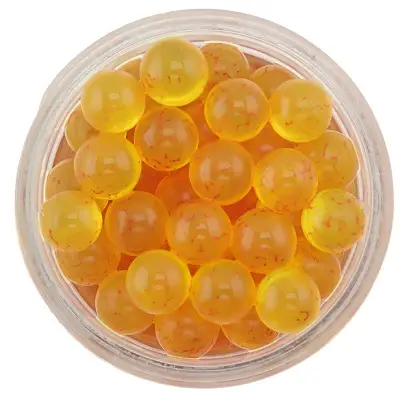
Soft beads made of softer plastic or rubber can also be effective for catching steelhead.
Soft beads are often rigged directly onto the hook or threaded onto the leader, and they offer easier removal and replacement compared to hard beads.
While some anglers believe that steelhead tend to hold onto soft beads longer since they are soft like reel salmon eggs, I’m not entirely sure of this.
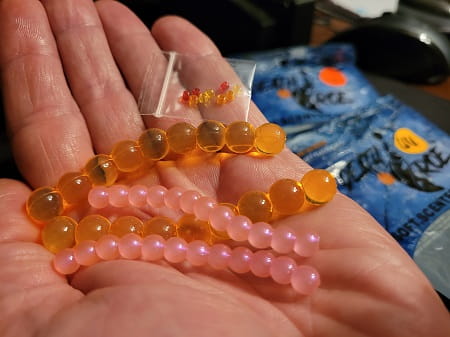
Nonetheless, soft beads can be a worthwhile option to try, especially in situations where hard beads may not be as effective.
If I had to guess, I would say hard beads are used 90% more than soft beads.
The best soft bead eggs are:
Tips for Rigging Beads
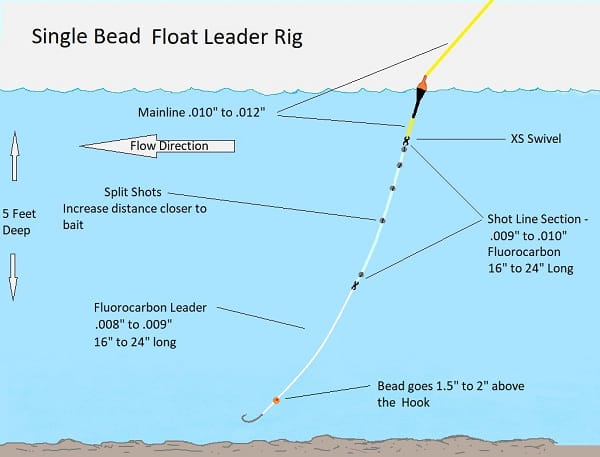
Proper bead placement and rigging are essential for successful steelhead fishing.
Positioning the bead approximately 1.5 to 2 inches above the hook offers several advantages, and this is how most anglers around the Great Lakes fish.
However, check the fishing regulations as positioning the beads on the line means you are using a bare hook, which is not permitted in some areas.
For full leader setups, check out: 5 Best Steelhead Rigs
Recommended Hooks For Beads
Hooks such as the Raven Specimen hooks and Gamakatsu Octopus hooks have proven to be effective with beads.
The hook size should correspond to the bead size, current speed, water depth, and river clarity.
Generally, hooks ranging from size 6 to size 10 are suitable for steelhead in all types of water.
Size 12 and size 14 hooks are too small and may not provide sufficient hooking and holding power. They may also bend.
Hooks larger than size six can weigh down the bead, affecting its natural drift and potentially deterring fish from biting.
For most clear to slightly murky water conditions, I will use a size eight or ten hook. In dirtier water or faster currents, I like to use the size six hook.
Why place the bead on the line?
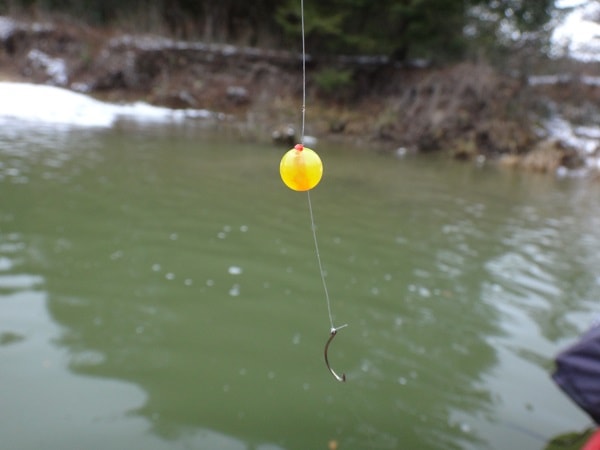
Placing the hook farther from the bead reduces the likelihood of the fish detecting it, resulting in more hookups. Secondly, when the fish inhales the bead, the hook tends to get caught on the outside of the mouth as the bead is going deep in the mouth, which improves hook-setting and hook-holding efficiency.
Avoid rigging the bead too close to the hook, as this can lead to deep hooking the fish in the throat or decreased hookup rates.
Securing Beads to the Line
There are several methods for securing beads to the line, including rubber bead pegs which I use the most, toothpicks broken off or cut to length, bobber stops, special loop knots, and even small rubber bands.
Rubber bead pegs, such as the TroutBead pegs, are recommended for their ability to allow the bead to slide when a fish takes the bait, which I and other guides believe results in better hook sets.
It is important to choose a method that securely fastens the bead so it does not slip on its own.
Organizing and Storing Beads
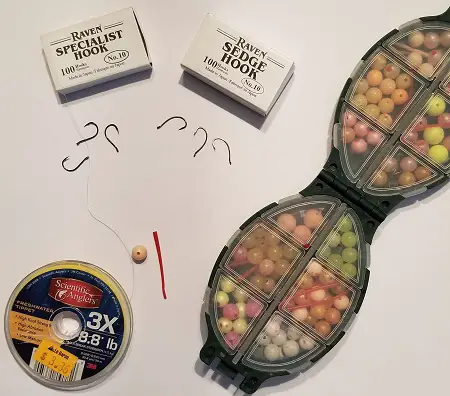
Managing a wide assortment of beads can be challenging, but proper organization ensures efficiency on the water.
Using bead boxes with individually covered compartments helps prevent accidental spills and allows for easy access to different bead sizes and colors.
Carrying a smaller day box with a selection of beads suitable for the fishing trip at hand can help reduce bulk and facilitate quick changes.
Guide Tip: Many of my clients and buddies have been impressed with this tip. Pre-tying bead rigs in advance saves time on the water and enables seamless transitions between different bead setups. With a pre-rig, I can change a bead in less than one minute.
This has been a lifesaver in icy cold conditions since rigging a bead from scratch can take some anglers over 5 minutes.
Effective Hook Sets
When a steelhead grabs a real salmon egg, it’s soft, juicy, has some scent or taste, and they will swallow it. Beads are hard as a rock with no taste so the fish are likely to spit them out quickly if given the chance. How quick? Less than 2 seconds!
Therefore, developing a trigger-happy approach to hook sets can significantly improve your hookup rates when fishing steelhead with beads. This means the second your float moves, set the hook. I’ll often set the hook before the float even goes under.
Do Beads Snag Fish?
I’ve heard anglers tell me they stopped using beads because they snag too many steelhead in the belly, fins, or tail. They believe that beads snag fish! But is this true?
My answer is no, beads do not snag fish, anglers snag fish. Let me explain.
Yes, beads tend to snag more fish than other baits, but that is the fault of the anglers doing something wrong.
Snagging fish by accident can often be attributed to delayed hook sets. Slow reactions on the angler’s part may result in the fish already spitting out the bait before the hook is properly hooked.
Since the bead is spit out so quickly, by the time the angler reacts to the float going down, the bead is out of the mouth and alongside the fish as the hook is set. This quick spit or slow hookset results in snagging the steelhead in the body.
By setting the hook quicker, which I do, and which I teach my clients to do, you can minimize accidental snags and increase your chances of landing fish successfully. I very rarely snag steelhead with beads. I’d guess one out of 500 will be snagged.
Don’t let a few snagged fish prevent you from taking advantage of catching a ton of steelhead with beads.
Tight Lines,
Graham

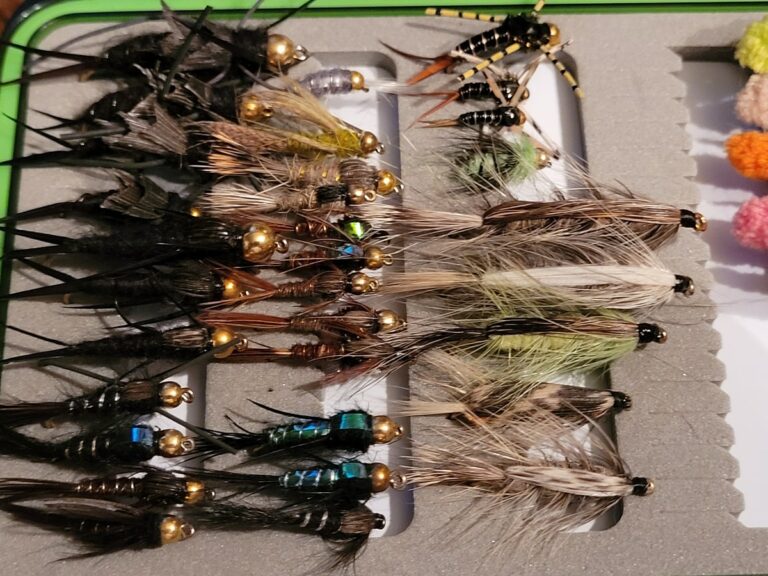
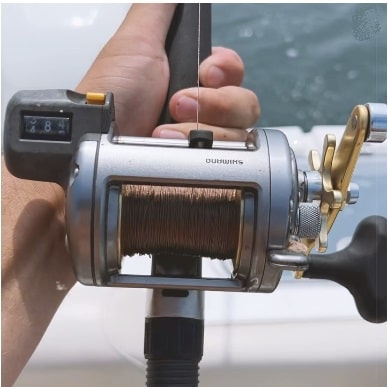
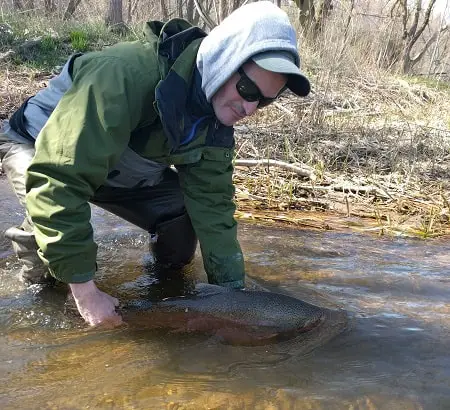
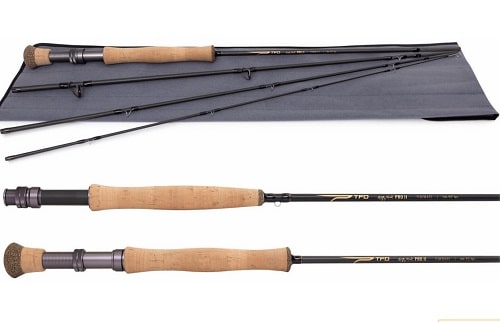
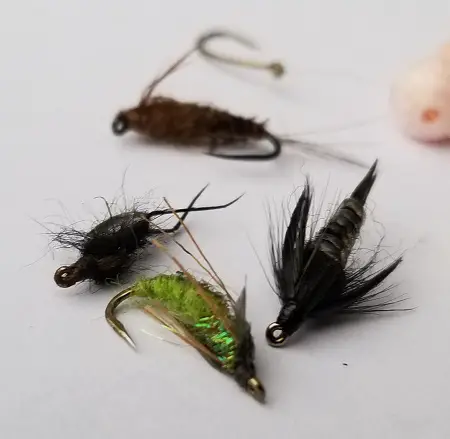
Ok – suggestions / tips on how NOT to get my double bead set up tangled in my shot line while casting.
Hey Dave,
This is a common issue and i’ve seen it a lot and have helped fix this issue for many of my clients. However, becuase I’m not able to be with you on the water to see what you are doing wrong, it’s hard to say which of the 3 or 4 reasons are your problem.
Tangles are created by slack in the line, so I tell my clients to “stop putting slack in the line and your tangles will disappear”. Easier said than done right?
Slack and tangles are caused in multiple places during your cast. 1 when you reel the leader it, 2- the initial start of your cast, 3 -and most often, when your rig (leader, weight, beads, and float) all hit the water. All of this can be fixed. In short, keep our rod tip steady, leave more line out when you reel in and cast, keep the leader straight at all times, and smooth out your cast. Lastly, don’t let your leader rig land in a pile, keep it straight.
I just did a short article for you, and other reader, explaining each of these in more detail, and my tips on what to do to prevent them. See it at https://troutandsteelhead.net/leader-tangles-when-float-fishing/